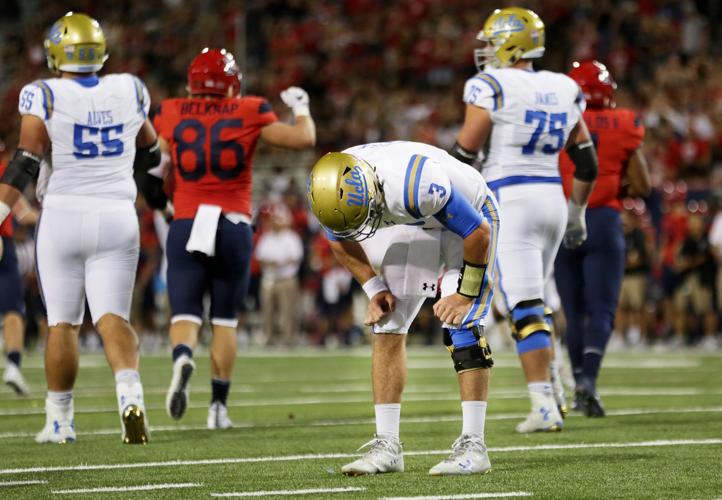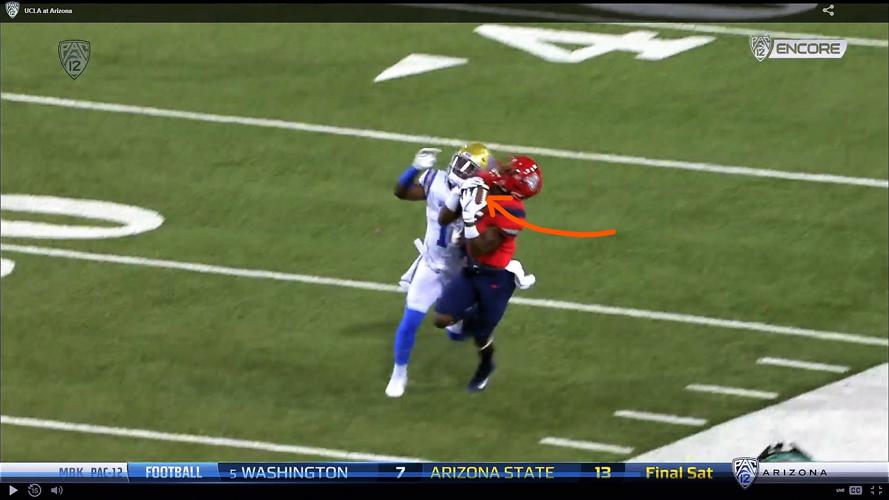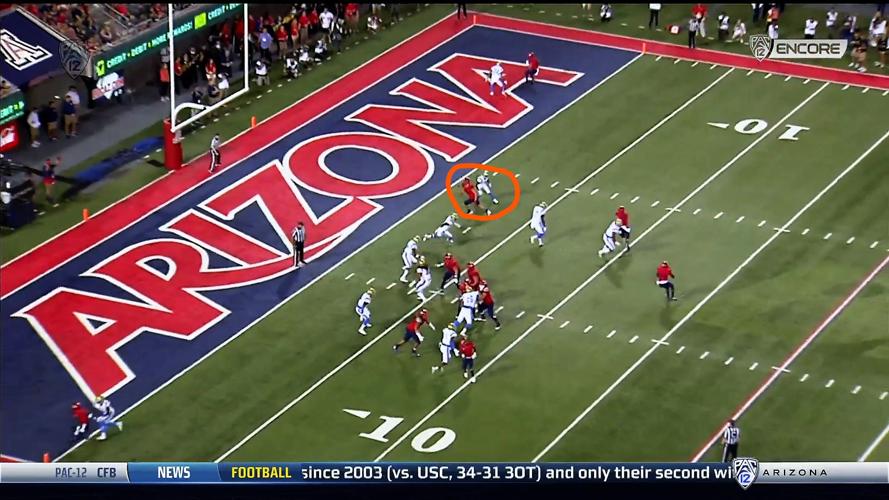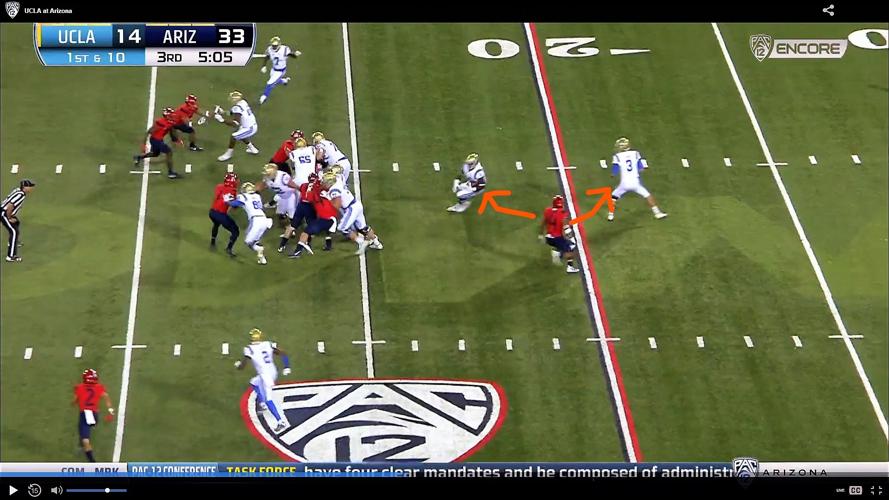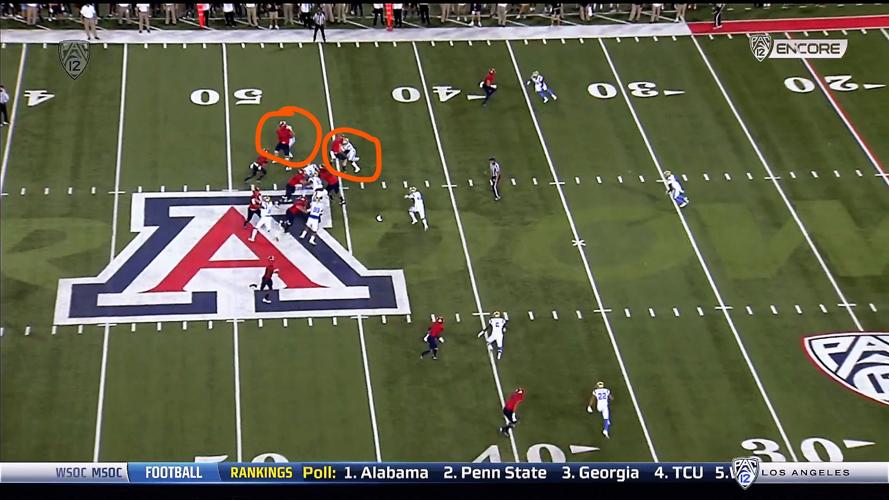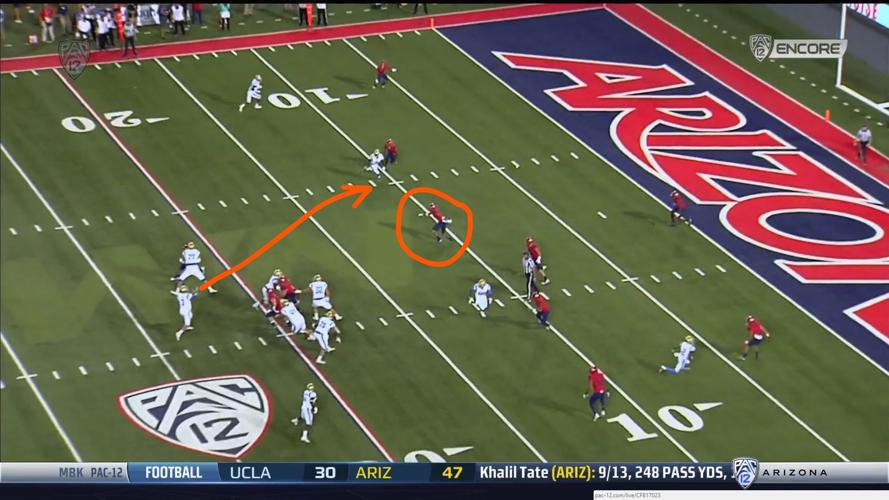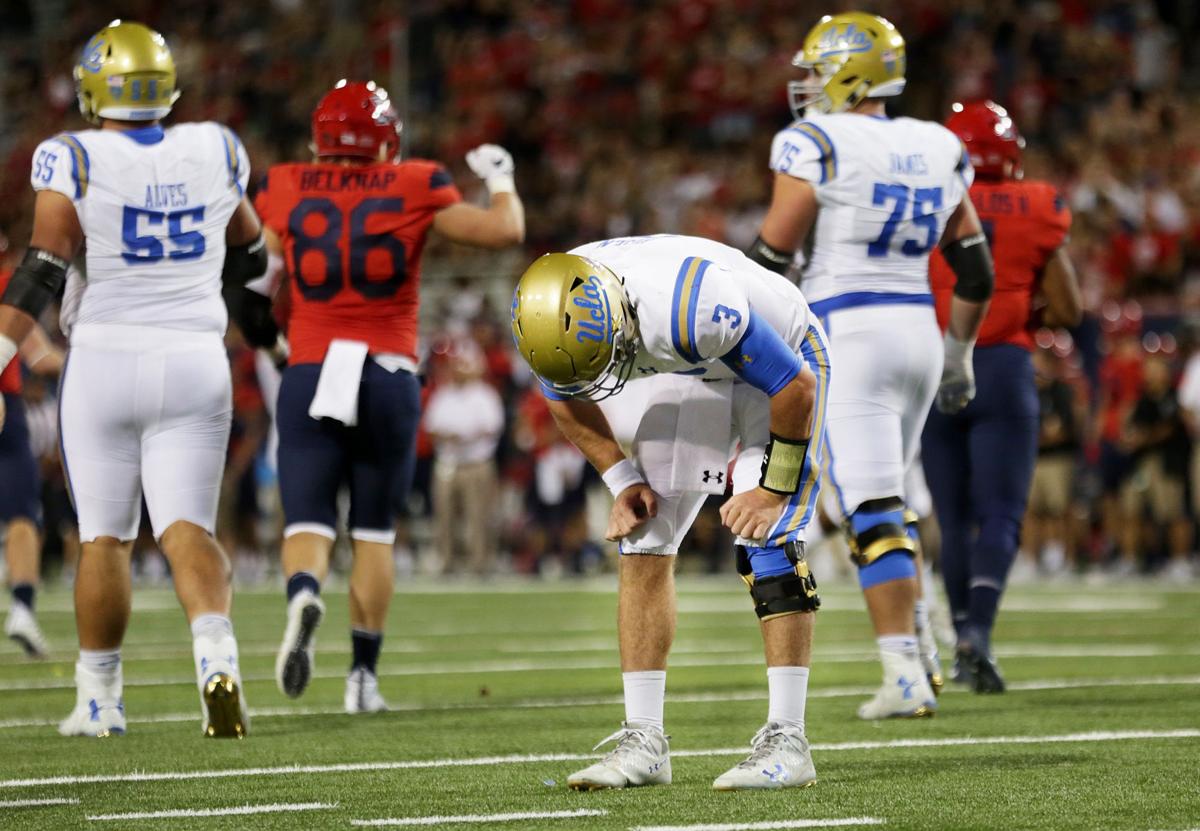Every Monday throughout the season, we’ll take a look back at the Arizona Wildcats’ previous game after re-watching it via the TV broadcast and present five key takeaways. Here are the five from the UA’s 47-30 victory over UCLA on Saturday night:
1. True dual threat

Khalil Tate hit Shun Brown in stride on this 53-yard strike in the first quarter.
Khalil Tate did it again. You can’t help but be impressed with the sophomore’s astounding athletic ability, instincts and poise under pressure. But what impressed me most in his first start of 2017 was the way he passed the ball. First off, Tate showed excellent patience in the pocket. He didn’t take off at the first sign of trouble. Second, his accuracy was off the charts. The two deep passes he hit – 53 yards to Shun Brown in the first quarter, 44 to Tony Ellison in the fourth – could not have been placed any better. Third, when Tate did miss, they were safe misses. Did he overthrow Brown in the end zone in the first quarter? Yes. But it was a tight-window throw, with two defenders nearby, and only one player had a chance to catch the ball – Brown. To me, Tate’s ability as a passer is what separates him from Brandon Dawkins, who is a different but excellent runner in his own right. I also don’t want to turn this or any comparison piece into a Dawkins-bashing session. As a backup QB, he’s as good an option as there is the Pac-12. Think Oregon wouldn’t like to have Dawkins right about now?
2. The Tate effect

With the defense locked in on Tate, Trevor Wood is able to slip into the end zone for a touchdown.
The Bruins focused the vast majority of their attention on Tate and still couldn’t stop him. Not only that, his presence – the threat of him doing something – opened up the offense for others. There was no better example of this than Tate’s 6-yard touchdown pass to tight end Trevor Wood late in the first half. After taking the snap, Tate drifted to his right. As this was happening, the UCLA defender who was supposed to check Wood was eyeballing Tate. Wood broke into the clear, and it was an easy pitch-and-catch. Another example: On the 44-yard pass to Ellison, safety Jaleel Wadood lined up about 10 yards beyond the line of scrimmage. He crept up at the snap, and a ball fake sucked him in even more. All three receivers had one-on-ones. Tate just so happened to pick Ellison. Finally, with the defense keying on Tate, the running game opened up for the running backs. The blocking was better, and UCLA wasn’t very good, but Tate clearly had a lot to do with it. It was only a matter of time.
3. Rattling Rosen

There might have been a method to the apparent madness of UA defenders such as Kylan Wilborn zeroing in on Josh Rosen on zone-read runs.
It kept happening, and I kept wondering why: Why would Arizona defenders go after Josh Rosen on UCLA’s version of zone-read plays? They aren’t zone reads in the strictest sense; Rosen isn’t likely to keep the ball, and if he does, that’s probably a win for the defense. Yet about a half-dozen times, UA defenders – whether it was Kylan Wilborn or Parker Zellers – would ignore the running back and take a shot at Rosen. It didn’t seem like a sound strategy; Wilborn’s perimeter pursuits, in particular, opened up inside running lanes. And Zellers ended up getting ejected for targeting. (That was the correct call, by the way. Zellers did make helmet-to-helmet contact with Rosen. It wasn’t an intentional strike, but Zellers could have taken a lower launch angle.) But UCLA coach Jim Mora indicated that all the hits on Rosen might have had a cumulative effect: He lost his rhythm as a passer. Whether this was an intentional strategy by the Wildcats or a product of overexuberance is unclear. Whatever the case, it worked.
4. This time it’s personnel

Perfect blocks by Jacob Alsadek and Bryce Wolma sprung Tate for this 45-yard touchdown.
Every week we provide some notes on individual players, so here goes … Freshman TE Bryce Wolma caught only two passes for 16 yards, but I thought this was his best performance as a blocker. He and OG Jacob Alsadek – who might have had his best game of the season – threw the key blocks on Tate’s 45-yard TD run on the opening possession. … I’m a big fan of J.J. Taylor’s work, but there’s a clear difference between him and Nick Wilson on inside runs. The bigger Wilson is able to power through defenders if necessary; that just isn’t Taylor’s game. … UCLA used screen and play-action passes to great effect, a smart strategy against Arizona’s young, aggressive defense. It’ll be interesting to see if future opponents employ a similar strategy. … Wilborn had a terrific game; he just seems to have a knack for finding the football and/or the quarterback. But as good as he is now, he’ll be better next year. He and several of the freshmen just don’t have the strength to hold up play after play after play. A full offseason in the weight room will do them good. … Why did the coaching staff eventually go with Kwesi Mashack over Jarvis McCall Jr. at free safety in place of Scottie Young Jr., who left with an apparent right-knee injury in the first quarter? Mashack is sounder. McCall too often goes for the kill shot instead of wrapping up.
5. The great wide open

Rosen never saw Dane Cruikshank in zone coverage; Cruikshank's INT put the finishing touch on Arizona's second straight win.
Whatever you thought about the Pac-12 a week ago no longer applies. The Washington schools fell and dropped out of the top 10. USC barely beat Utah at home (although the Trojans did find a way to win, and that’s something). Oregon has fallen apart without its quarterback. What’s the upshot for Arizona? As of today, the UA and Arizona State are tied for second in the Pac-12 South behind USC. The Wildcats and Sun Devils are 2-1; the Trojans are 4-1. I don’t think Arizona will catch USC, but second place in the division is legitimately in play if Tate stays healthy and continues to play as well as he has. When you look at the second-half schedule – at Cal, vs. WSU, at USC, vs. Oregon State, at Oregon, at ASU – five of the six seem winnable (the lone exception: at USC). I’m not saying Arizona will win five of six, but it’s not completely unreasonable. Heading into the Colorado game two weeks ago, can you imagine that being a serious conversation?


